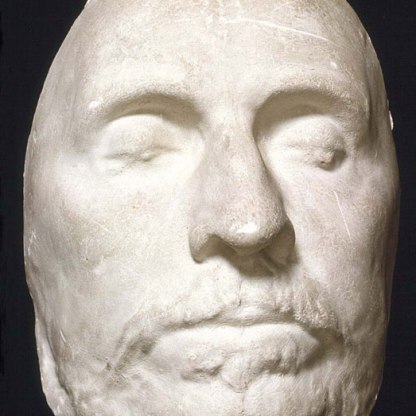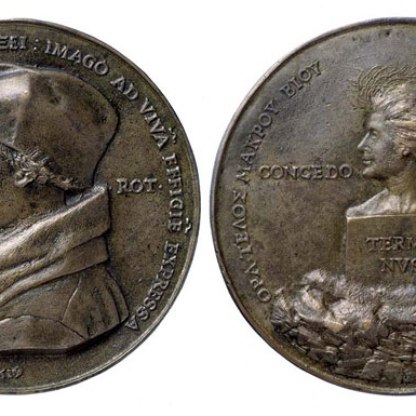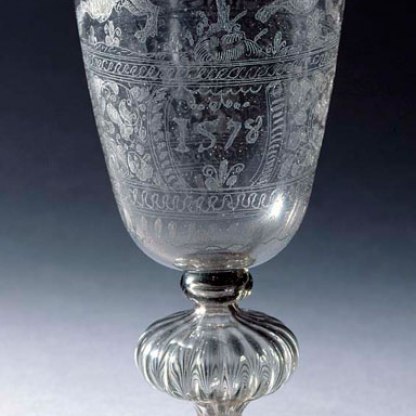Copy of the Portland Vase

When I first engaged in this work and had only Montfaucon['s prints] to copy, I proceeded with spirit and sufficient assurance that I should be able to equal or excel, if permitted, that copy of the vase; but now that I can indulge myself with full and repeated examinations of the original work itself, my crest is much fallen.
Josiah Wedgwood to Sir William Hamilton, June 1786
This vessel is an eighteenth-century copy of the Portland Vase, the most sophisticated example of ancient Roman cameo glass ever to have been discovered. The original vase probably dates from the first century BCE, and is now held in the British Museum. The great collector of antiquities, Sir William Hamilton, had bought it to England from Italy in 1783, and the following year sold it to Margaret, dowager duchess of Portland, from whom it takes its name. Its decorative scheme – the appealing combination of white glass on dark blue – immediately caught the imagination of the great Staffordshire potter, Josiah Wedgwood.
Wedgwood and his assistants laboured for three years to replicate in clay the Roman glass masterpiece. In 1788 when a doctor advised him to take a holiday, Wedgwood promised that he would – 'as soon as the Portland vase is completed'. Eventually, in 1789, he had produced a copy of sufficient quality to display.
The first person outside the Wedgwood Factory to see the finished article was the potter's friend, the physician and botanist Erasmus Darwin, grandfather of Charles Darwin. The vase now in the Fitzwilliam is probably the very copy that Wedgwood sent to Darwin in September 1789, with strict instructions not to show it to anyone outside his family. Shortly after its arrival, however, Darwin wrote to Wedgwood:
I have disobeyed you and shown your vase to two or three; but they were philosophers, not cogniscenti. How can I possess a jewel, and not communicate the pleasure to a few Derby philosophers?
The fame of the work spread. Sir Joshua Reynolds, the President of the Royal Academy of Arts, publicly declared that it was a faithful copy of the original. Admired by royalty, copies were toured around Europe.
Technically, it is a brilliant piece of work. It is made from jasper, a type of stoneware developed by Wedgwood in the 1770s that was hard enough to be carvable and could be worked on a lathe. The body is coloured dark blue-black, while the cameo decoration consists of applied white jasper reliefs, painted with a thin black slip in places to suggest the translucency of the original glass.
The exact meaning of the figures on the vase has been debated since the original first came to light in the sixteenth century. Some see it as a depiction of the divine conception and ancestry of the first Roman emperor, Augustus. Others interpret the figures as the mythical couple Peleus and Thetis and their relations. Erasmus Darwin himself interpreted the scene in general terms as a comment on the human condition. In The Botanical Garden, a lengthy poem published between 1789 and 1791, he praised Wedgwood's copy and described the scene thereon:
Here by fallen columns and disjoined arcades, / On mouldering stones beneath deciduous shades, / Sits humankind in hieroglyphic state, / Serious and pondering on their changeful fate;/ While with inverted torch and swimming eyes / Sinks the fair shade of Mortal Life, and dies.
Themes and periods
Data from our collections database
Portland Vase copy, blue-black jasperware with applied white reliefs; on the sides classical scenes; on the base, the head of Paris
Jasper, solid blue-black with white reliefs. Squat ovoid body with incurved neck and everted rim, with two elbowed handles, and disk base. Decorated with two scenes separated by bearded male masks below the handles. Reading from left to right: Side 1. Two square pillars supporting an architrave, behind which is a small shrub. In front of the pillars a nude young man holding a drape behind him in his right hand, steps forward to take the arm of a partly draped woman who sits on the ground, looking back at him, and has a snake in her lap. Eros, holding a bow in his left hand and a torch in his right, flies overhead looking back to the young man. On the right, a bearded man stands in three-quarter profile to left, with his right foot on a heap of stones in front of a tree. He rests his chin on his right hand and his right elbow on his right thigh. To the right behind him there is a slender tree. Side 2. A square pillar with a capital, beside which sits a nude young man on a pile of rocks. He has a drape over his right leg, and looks to the right towards a woman, who reclines on pile of rocks in front of a tree. Her lower body is draped, and she holds a torch pointing downwards in her left hand, and has her right arm bent with the hand on her head. In front of her is a square stone with central hole and chamfered edge. On the right is a nude woman, seated on a separate pile of rocks, looking back towards the other two figures. She is partly draped, and holds a sceptre in her left hand. On the base, there is a spray of foliage above the head of a young man, in profile to right, wearing a Phrygian cap, and a cloak, and having his right forefinger to his lips. Accompanied by original fitted travelling case (C.20A-1980)
Dr Erasmus Darwin (1731-1802), Breadsall Priory, Derbyshire; Miss Emma Darwin (1784-1818); Sir Francis Sacheverel Darwin MD (1786-1859); his widow, Harriet Jane, Lady Darwin (d.1866); Reginald Darwin (1818-92), Tern; Admiral Sacheverel Darwin (1844-1900), Tern; his half-second cousin, Charles Darwin's second son, Sir George Howard Darwin FRS (1845-1912), Cambridge; Sir Charles Galton Darwin FRS (1887-1862); George Pember Darwin, by whom lent to the Fitzwilliam in 1963.
Legal notes
Bought with the Cunliffe Fund, Grant-in-Aid from the Victoria and Albert Museum and a contribution from the National Heritage Memorial Fund, 1984
Acquisition and important dates
- Method of acquisition: Bought
- Dates: 1984-04-30
Dating
The production of jasper ware copies of the cameo glass Portland Vase was one of Wedgwood's greatest achievements. The dowager Duchess of Portland, who purchased it from Sir William Hamilton in 1784, died in 1785, and a year later Wedgwood borrowed it from her son, the third Duke of Portland, who had bought it at the sale of his mother's collection. After studying it thoroughly, Wedgwood, his son Josiah, and his modellers Webber and Hackwood experimented for three years before the first successful copy was achieved in the late summer of 1789. The exact number of Portland Vase copies made before Wedgwood's death in 1795 is not clear. Surveys of extant vases and documents in the Wedgwood archive indicate that it was between forty and fifty, of which some were defective. This is one of only three known to have retained their original travelling cases.
- 18th Century, Late
- George III
- Production date: circa AD 1789 : probably early autumn of 1789
Maker(s)
- Wedgwood, Josiah Factory
Note
The production of jasper ware copies of the cameo glass Portland Vase was one of Wedgwood's greatest achievements. The dowager Duchess of Portland, who purchased it from Sir William Hamilton in 1784, died in 1785, and a year later Wedgwood borrowed it from her son, the third Duke of Portland, who had bought it at the sale of his mother's collection. After studying it thoroughly, Wedgwood, his son Josiah, and his modellers Webber and Hackwood experimented for three years before the first successful copy was achieved in the late summer of 1789. The exact number of Portland Vase copies made before Wedgwood's death in 1795 is not clear. Surveys of extant vases and documents in the Wedgwood archive indicate that it was between forty and fifty, of which some were defective. This is one of only three known to have retained their original travelling cases.
Place(s) associated
- Etruria
Materials used in production
Read more about this recordOther highlight objects you might like
Suggested Curating Cambridge products
Sign up to our emails
Be the first to hear about our news, exhibitions, events and more…





